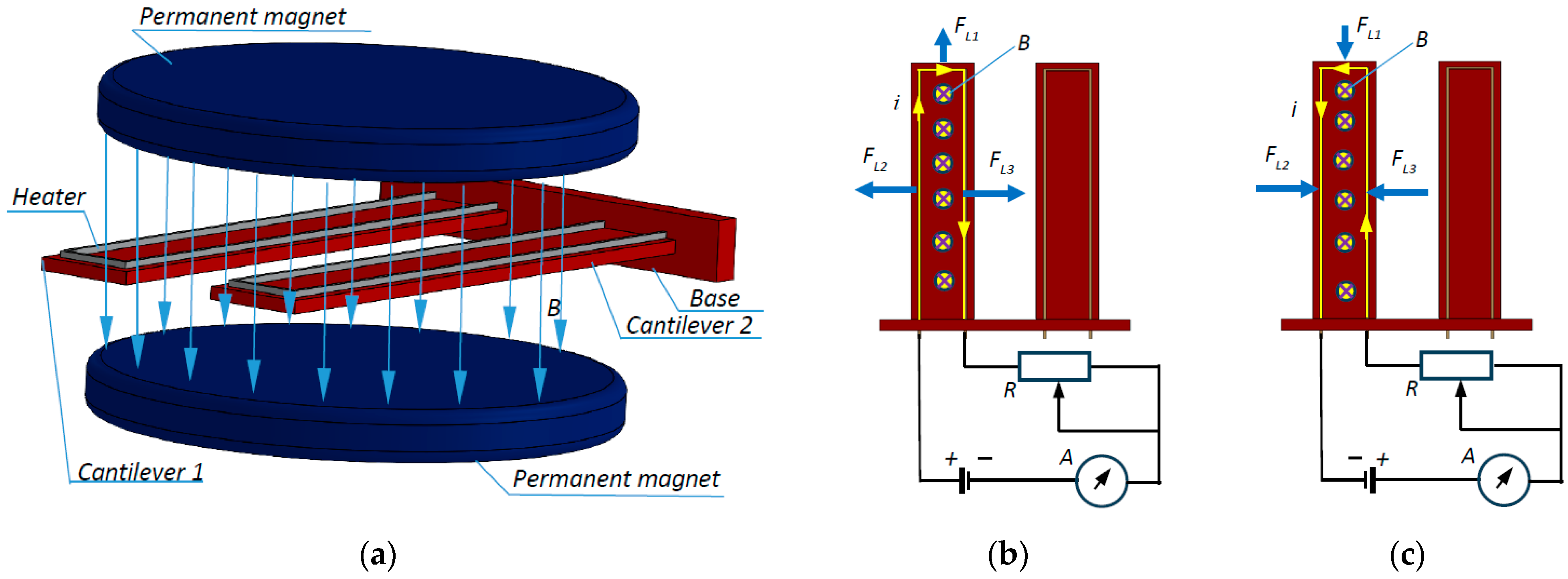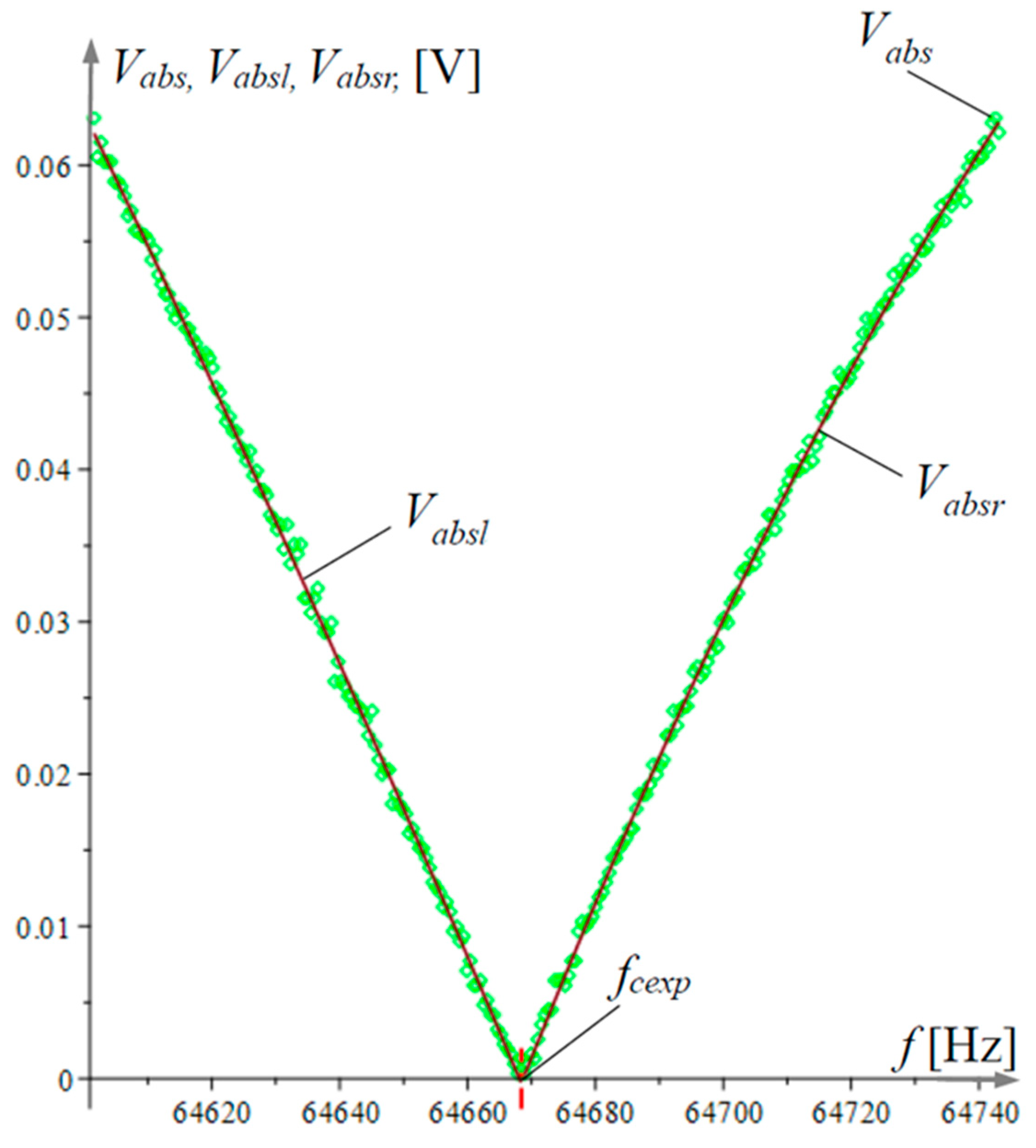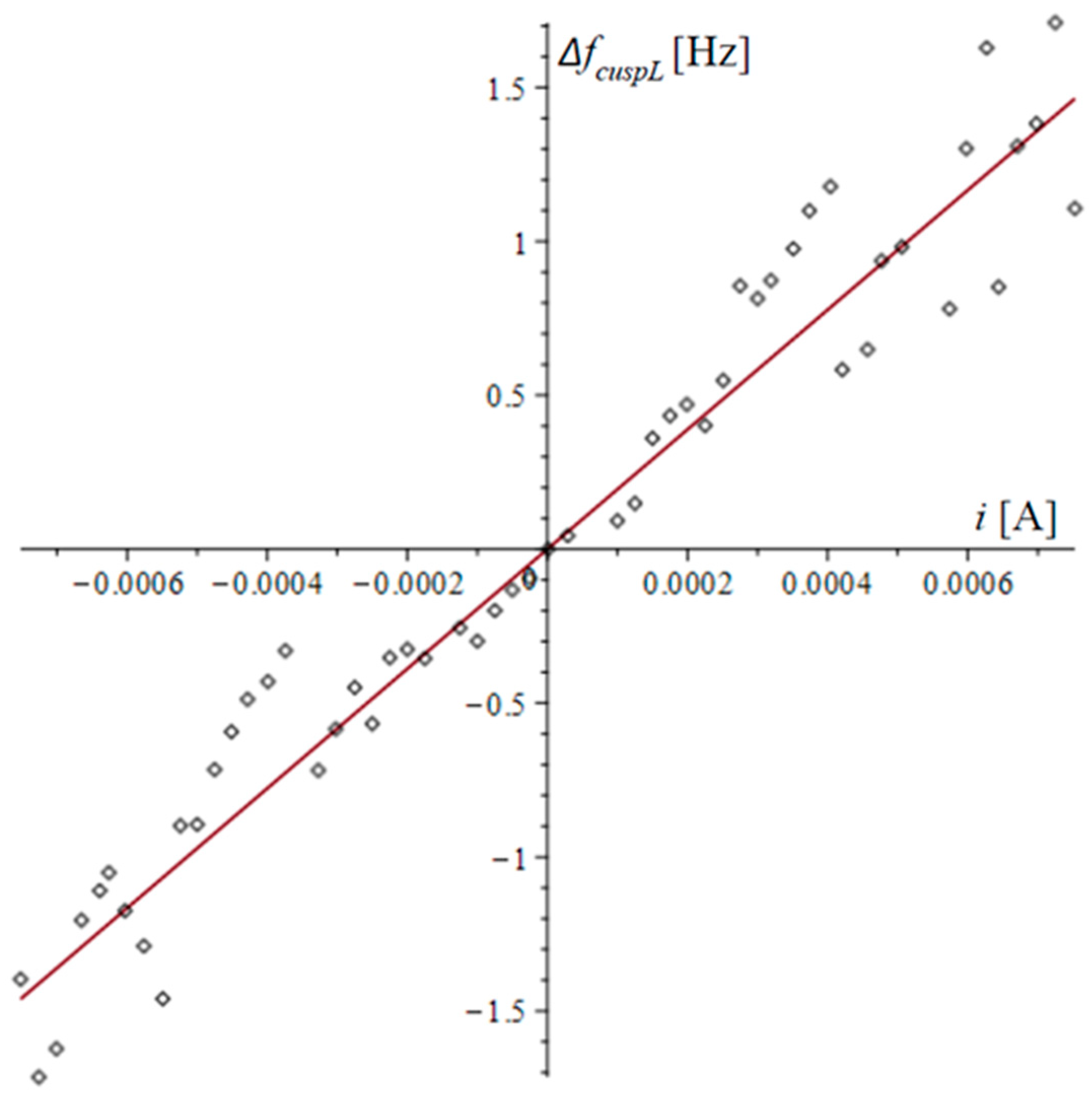Evaluation of the Influence of Lorentz Forces on the Natural Frequencies of a Dual-Microcantilever Sensor for Ultralow Mass Detection
Abstract
1. Introduction
2. Materials and Methods: Principle of Operation and Design of the Investigated Piezoresistive Dual-Microcantilever Sensor
3. Theoretical Study of the Influence of Lorentz Forces on the Natural Frequency of a Microcantilever with Anisotropic Properties
4. Experimental Study of the Influence of Lorentz Forces on the Amplitude–Frequency Response of a Dual-Microcantilever Sensor
5. Conclusions
Author Contributions
Funding
Institutional Review Board Statement
Informed Consent Statement
Data Availability Statement
Conflicts of Interest
References
- Breuer, K.S.; Park, J.; Henoch, C. Actuation and Control of a Turbulent Channel Flow Using Lorentz Forces. Phys. Fluids 2004, 16, 897–907. [Google Scholar] [CrossRef]
- Herrera-May, A.; Soler-Balcazar, J.; Vázquez-Leal, H.; Martínez-Castillo, J.; Vigueras-Zuñiga, M.; Aguilera-Cortés, L. Recent Advances of MEMS Resonators for Lorentz Force Based Magnetic Field Sensors: Design, Applications and Challenges. Sensors 2016, 16, 1359. [Google Scholar] [CrossRef] [PubMed]
- Kwang, W.O.; Chong, H. Ahn Magnetic Actuation. In Comprehensive Microsystems; Gianchandani, Y.B., Tabata, O., Zappe, H., Eds.; Elsevier Ltd.: Amsterdam, The Netherlands, 2008; Volume 2, pp. 42–43. [Google Scholar]
- Allen, J.J. Micro Electro Mechanical System Design, 1st ed.; Taylor & Francis Group, LLC.: New York, NY, USA, 2005; Volume 1. [Google Scholar]
- Basha, H.; Nandeppanavar, M.M.; Reddy, G.J. Dissipative Lorentz Force Influence on Mass Flow over a Micro-cantilever Sensor Sheet under Magnetic Ohmic Heating. ZAMM J. Appl. Math. Mech. Z. Angew. Math. Mech. 2024, 104, 55. [Google Scholar] [CrossRef]
- Lv, X.; Wei, W.; Mao, X.; Yang, J.; Yang, F. A Novel MEMS Actuator with Large Lateral Stroke Driven by Lorentz Force. J. Micromech. Microeng. 2015, 25, 025009. [Google Scholar] [CrossRef]
- Keplinger, F.; Kvasnica, S.; Jachimowicz, A.; Kohl, F.; Steurer, J.; Hauser, H. Lorentz Force Based Magnetic Field Sensor with Optical Readout. Sens. Actuators A Phys. 2004, 110, 112–118. [Google Scholar] [CrossRef]
- Gkotsis, P.; Lara-Castro, M.; López-Huerta, F.; Herrera-May, A.L.; Raskin, J.-P. Mechanical Characterization and Modelling of Lorentz Force Based MEMS Magnetic Field Sensors. Solid State Electron. 2015, 112, 68–77. [Google Scholar] [CrossRef]
- Treutler, C.P.O. Magnetic Sensors for Automotive Applications. Sens. Actuators A Phys. 2001, 91, 2–6. [Google Scholar] [CrossRef]
- Li, M.; Nitzan, S.; Horsley, D.A. Frequency-Modulated Lorentz Force Magnetometer with Enhanced Sensitivity via Mechanical Amplification. IEEE Electron. Device Lett. 2015, 36, 62–64. [Google Scholar] [CrossRef]
- Mbarek, S.B.; Alcheikh, N.; Ouakad, H.M.; Younis, M.I. Highly Sensitive Low Field Lorentz-Force MEMS Magnetometer. Sci. Rep. 2021, 11, 21634. [Google Scholar] [CrossRef]
- Tu, C.; Ou-Yang, X.; Wu, Y.; Zhang, X. Single-Structure 3-Axis Lorentz Force Magnetometer Based on an AlN-on-Si MEMS Resonator. Microsyst. Nanoeng. 2024, 10, 58. [Google Scholar] [CrossRef]
- Lee, B.; Prater, C.B.; King, W.P. Lorentz Force Actuation of a Heated Atomic Force Microscope Cantilever. Nanotechnology 2012, 23, 055709. [Google Scholar] [CrossRef] [PubMed]
- Alunda, B.O.; Lee, Y.J. Review: Cantilever-Based Sensors for High Speed Atomic Force Microscopy. Sensors 2020, 20, 4784. [Google Scholar] [CrossRef]
- Somnath, S.; Liu, J.O.; Bakir, M.; Prater, C.B.; King, W.P. Multifunctional Atomic Force Microscope Cantilevers with Lorentz Force Actuation and Self-Heating Capability. Nanotechnology 2014, 25, 395501. [Google Scholar] [CrossRef]
- Zhang, W.; Lee, J.E.-Y. Frequency-Based Magnetic Field Sensing Using Lorentz Force Axial Strain Modulation in a Double-Ended Tuning Fork. Sens. Actuators A Phys. 2014, 211, 145–152. [Google Scholar] [CrossRef]
- Liepe, M.; Moeller, W.D.; Simrock, S.N. Dynamic Lorentz Force Compensation with a Fast Piezoelectric Tuner. In Proceedings of the 2001 Particle Accelerator Conference (Cat. No.01CH37268), Chicago, IL, USA, 18–22 June 2001; IEEE: New York, NY, USA, 2001; pp. 1074–1076. [Google Scholar]
- Mehdizadeh, E.; Kumar, V.; Pourkamali, S. Sensitivity Enhancement of Lorentz Force MEMS Resonant Magnetometers via Internal Thermal-Piezoresistive Amplification. IEEE Electron. Device Lett. 2014, 35, 268–270. [Google Scholar] [CrossRef]
- Shiraishi, N.; Kimura, M.; Ando, Y. Basic Characteristics of Polycarbonate-Based Dual Cantilever Sensors for Detecting VOC. Mech. Eng. J. 2014, 1, MN0055. [Google Scholar] [CrossRef][Green Version]
- Gurjar, M.; Jalili, N. Toward Ultrasmall Mass Detection Using Adaptive Self-Sensing Piezoelectrically Driven Microcantilevers. IEEE/ASME Trans. Mechatron. 2007, 12, 680–688. [Google Scholar] [CrossRef]
- Toda, M.; Inomata, N.; Ono, T.; Voiculescu, I. Cantilever Beam Temperature Sensors for Biological Applications. IEEJ Trans. Electr. Electron. Eng. 2017, 12, 153–160. [Google Scholar] [CrossRef]
- Abedinov, N.; Grabiec, P.; Gotszalk, T.; Ivanov, T.; Voigt, J.; Rangelow, I.W. Micromachined Piezoresistive Cantilever Array with Integrated Resistive Microheater for Calorimetry and Mass Detection. J. Vac. Sci. Technol. A Vac. Surf. Film. 2001, 19, 2884–2888. [Google Scholar] [CrossRef]
- Ramos, D.; Calleja, M.; Mertens, J.; Zaballos, A.; Tamayo, J. Measurement of the Mass and Rigidity of Adsorbates on a Microcantilever Sensor. Sensors 2007, 7, 1834–1845. [Google Scholar] [CrossRef]
- Jin, D.; Li, X.; Liu, J.; Zuo, G.; Wang, Y.; Liu, M.; Yu, H. High-Mode Resonant Piezoresistive Cantilever Sensors for Tens-Femtogram Resoluble Mass Sensing in Air. J. Micromech. Microeng. 2006, 16, 1017–1023. [Google Scholar] [CrossRef]
- Banchelli, L.; Todorov, G.; Stavrov, V.; Ganev, B.; Todorov, T. Investigating a Detection Method for Viruses and Pathogens Using a Dual-Microcantilever Sensor. Micromachines 2024, 15, 1117. [Google Scholar] [CrossRef] [PubMed]
- Banchelli, L.F.; Ganev, B.T.; Todorov, T.S. Sustainability Validation of a LabVIEW Based System for Biomarkers Detection. In Proceedings of the 2023 XXXII International Scientific Conference Electronics (ET), Sozopol, Bulgaria, 13–15 September 2023; IEEE: New York, NY, USA, 2023; pp. 1–6. [Google Scholar]
- Stavrov, V.; Stavreva, G.; Tomerov, G. Tester for Detection of Infectious Agents in Fluid. Bulgarian Patent BG113123A, 16 April 2020. [Google Scholar]
- Liu, C. Foundations of MEMS, 2nd ed.; Prentice Hall, 2 Pearson Education, Inc.: Upper Saddle River, NY, USA, 2011. [Google Scholar]
- McCarter, D.R.; Paquin, R.A. Isotropic Behavior of an Anisotropic Material: Single Crystal Silicon. In Proceedings SPIE Material Technologies and Applications to Optics, Structures, Components, and Sub-Systems; Robichaud, J.L., Krödel, M., Goodman, W.A., Eds.; SPIE: Paris, France, 2013; Volume 8837, p. 883707. [Google Scholar]
- Volterra, E.; Zachmanoglou, E.C. Dynamics of Vibrations; C.E. Merrill Books: New York, NY, USA, 1965; Volume 1. [Google Scholar]
- Meirovitch, L. Elements of Vibration Analysis, 2nd ed.; McGraw-Hill: New York, NY, USA, 1986. [Google Scholar]
- Lindroos, V.; Tilli, M.; Lehto, A. Handbook of Silicon Based MEMS Materials and Technologies; Elsevier: Amsterdam, The Netherlands, 2010; ISBN 9780815515944. [Google Scholar]
- Keyes, R.W. Electronic Effects in the Elastic Properties of Semiconductors. In Solid State Physics; Seitz, F., Turnbull, D., Ehrenreich, H., Eds.; Elsevier: Amsterdam, The Netherlands, 1968; Volume 20, pp. 37–90. [Google Scholar]







| Parameter | Symbol | Unit | Value |
|---|---|---|---|
| Magnetic flux density of the magnet stack | B | T | 0.0022 |
| Length 1 of the microcantilever 1 heater | M | 292 × 10−6 | |
| Length 2 of the microcantilever 1 heater | M | 148 × 10−6 | |
| Length of microcantilever 1 | M | 294 × 10−6 | |
| Length of microcantilever 2 | M | 292 × 10−6 | |
| Width of microcantilever 1 | M | 150 × 10−6 | |
| Width of microcantilever 2 | M | 172 × 10−6 | |
| Height of microcantilever 1 | m | 4 × 10−6 | |
| Height of microcantilever 2 | m | 4 × 10−6 | |
| Density of silicon | kg/m3 | 2329 * | |
| Mass of the silicon in cantilever 1 | kg | 4.11 × 10−10 | |
| Mass of the silicon in cantilever 2 | kg | 4.62 × 10−10 | |
| Young’s modulus of the n silicon in [110] direction | GPa | 170 ** | |
| Stiffness for n type silicon plane 100 in axis [010] | Pa | 63.94 × 109 ** | |
| Stiffness for n type silicon plane 100 in axis [001] | Pa | 79.51 × 109 ** | |
| Stiffness for n type silicon plane 100 in axis [110] | Pa | 165.65 × 109 ** | |
| Natural angular frequency of microcantilever 1 | s−1 | 10,402.535 | |
| Natural angular frequency of microcantilever 2 | s−1 | 10,568.028 | |
| Natural frequency of microcantilever 1 | Hz | 65,361.057 | |
| Natural frequency of microcantilever 2 | Hz | 66,400.888 | |
| Frequency of the cusp point | Hz | 65,889.063 | |
| Damping factor of microcantilever 1 | s−1 | 1554.755 | |
| Damping factor of microcantilever 2 | s−1 | 1675.886 |
Disclaimer/Publisher’s Note: The statements, opinions and data contained in all publications are solely those of the individual author(s) and contributor(s) and not of MDPI and/or the editor(s). MDPI and/or the editor(s) disclaim responsibility for any injury to people or property resulting from any ideas, methods, instructions or products referred to in the content. |
© 2024 by the authors. Licensee MDPI, Basel, Switzerland. This article is an open access article distributed under the terms and conditions of the Creative Commons Attribution (CC BY) license (https://creativecommons.org/licenses/by/4.0/).
Share and Cite
Banchelli, L.; Todorov, G.; Stavrov, V.; Ganev, B.; Todorov, T. Evaluation of the Influence of Lorentz Forces on the Natural Frequencies of a Dual-Microcantilever Sensor for Ultralow Mass Detection. Micro 2024, 4, 572-584. https://doi.org/10.3390/micro4040035
Banchelli L, Todorov G, Stavrov V, Ganev B, Todorov T. Evaluation of the Influence of Lorentz Forces on the Natural Frequencies of a Dual-Microcantilever Sensor for Ultralow Mass Detection. Micro. 2024; 4(4):572-584. https://doi.org/10.3390/micro4040035
Chicago/Turabian StyleBanchelli, Luca, Georgi Todorov, Vladimir Stavrov, Borislav Ganev, and Todor Todorov. 2024. "Evaluation of the Influence of Lorentz Forces on the Natural Frequencies of a Dual-Microcantilever Sensor for Ultralow Mass Detection" Micro 4, no. 4: 572-584. https://doi.org/10.3390/micro4040035
APA StyleBanchelli, L., Todorov, G., Stavrov, V., Ganev, B., & Todorov, T. (2024). Evaluation of the Influence of Lorentz Forces on the Natural Frequencies of a Dual-Microcantilever Sensor for Ultralow Mass Detection. Micro, 4(4), 572-584. https://doi.org/10.3390/micro4040035










